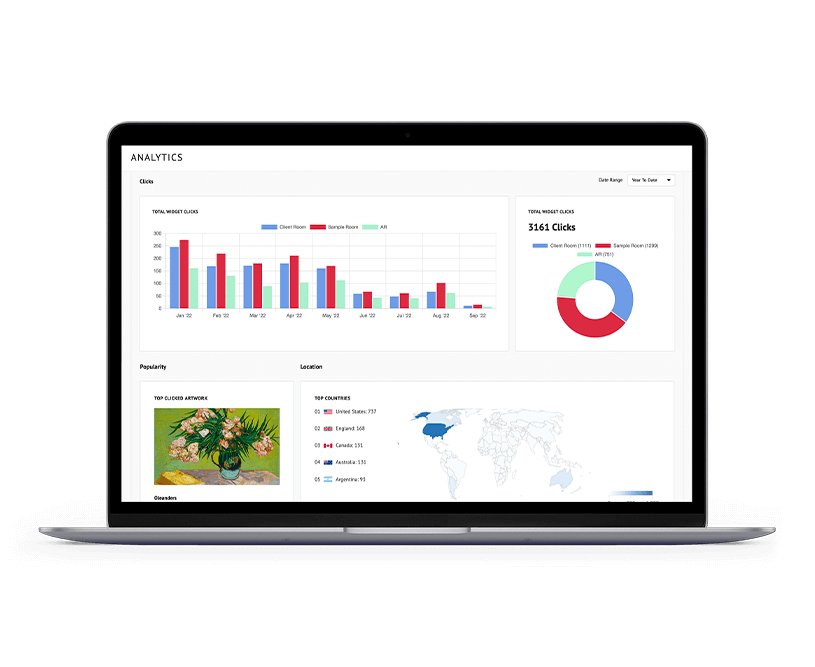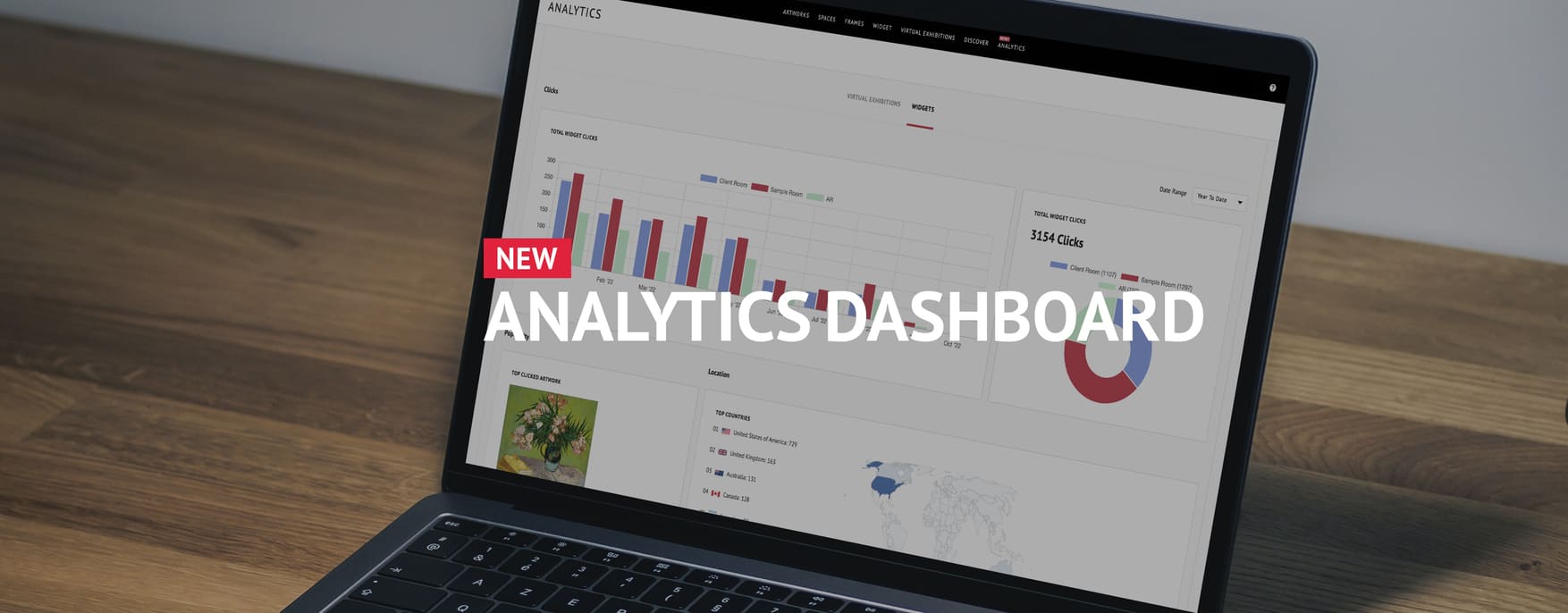Think about Art Marketing as a cycle of efforts that feeds itself, the repetition of its most successful actions enables it to keep going and growing. In its simpler terms, marketing refers to the efforts made by a brand to be seen, recognized, desired, and then consumed or acquired by a target audience. But what keeps the ball rolling? What makes a marketing strategy “good” and how does a team leader know in which direction to push to achieve their art business goals? That is where the world of analytics opens up.
Analytics is hard data based on user behavior around established stimuli, like how many times visitors click on the inquiry button of a certain art piece in an online art gallery. But a number is not just a number. Analytics is all about your interpretation of the actions made by visitors, collectors, and people interested in your collections. Analytics track visitors’ actions inside the (digital) spaces where you communicate about your gallery and the artworks you have curated. Let’s take a deep look into analytics and how they can help you shape your art business and marketing strategy to achieve your goals.

Contents
What is Art Marketing Analytics
The word Marketing tends to stir a bit of controversy in the art world. There is a general fear of being too “salesy” or stripping art of deeper meanings and passing it around as mere “content” scheduled to fill up a social media profile and feed the needs of an algorithm. The thing is: we fear what we don’t know.
The evolution of digital art and artist’s tools, as well as the spaces where people now interact with art (from Virtual Galleries to the Metaverse) and the forms and format art takes today (gifs, NFTs, crypto art, and more), asks for the art world to have a more amicable relationship with the digital marketing world and understand what concepts and strategies it can learn from it to grow.
Think of marketing as the frame that holds the art piece that is your brand. Marketing is both the strategy and its elements, all the efforts used to communicate your brand and its message to the world. And what is your brand? Well, that’s what you do and how you do it, what you represent, what your work says, and some people even say that is that lingering feeling that your work leaves on others (the same one that makes them come back to you). When your work speaks for itself, that’s when it has taken its “brand” form.
With this in mind, you can think of analytics not as numbers and graphics, but as data about behavior that gives you a clear picture of which communication channels and formats work the best to reach out to your target audience.
Analytics also lets you know what it takes (and sometimes how much it takes) for a visitor to follow a call to action (the precise interaction you want them to take according to your marketing goals). This data can help you understand which parts of your marketing strategy are working, which ones need improvement, and which ones can be dropped in order to make a better management of your resources in order to achieve your art business goals.

What does Analytics say about your Art Marketing Strategy
Analytics provides you with a real-time diagnosis of your art marketing strategy. Whether you have already established a business that is recognized in the art world, or you are giving your first steps to build a physical marketing business, a digital one, or a hybrid one, you need a business plan with clear goals that work as the blueprint for your growth.
A plan is made out of goals that are meant to be achievable in a certain time frame and should be measurable. To have a clearer idea, an example of an art marketing goal could be creating different streams of income like art advisory services or direct online purchases, another example could be generating awareness of your current collections. These are your marketable products and services. All business goals should translate into tangible actions and efforts that can be trackable and analyzed. That’s where analytics come into play.
Analytics can help you understand what actions led to the sale of a certain art piece, for example. That is a valuable insight that highlights which efforts have the best performance and helps to draft more effective marketing strategies.

Benefits of Analytics: insights and art marketing results
Have you ever heard of the term “funnel”? It is not a pipe to go Pollock on a canvas, in the marketing world this is the journey a potential customer goes through with you or your brand. It starts at the top with the mere awareness of your art business, it goes through them developing interest and then following through different actions that lead to the desired conversion. Meaning: the visitor completes the action you wanted them to, like making an inquiry or buying an art piece.
ArtPlacer offers a variety of features that can help you build that journey effectively and effortlessly. A 3D Virtual Gallery hosted on your website and with a shareable link that you can add to your email or social media communications can function as the top of the funnel by generating awareness of your collections and appeal to potential buyers.
Then you can get important insights about your audience and their interest with Analytics. From the overall number of visits to a certain Virtual Exhibition, to the top countries where your audience is coming from. You can understand what they like, and what peaks their interest and retarget them to achieve your goals. A big plus, this data can help you calculate your return on investment, meaning, you can know how much of your resources are invested in these marketing pushes and how are they performing, enabling you to make adjustments to boost your overall marketing plan and achieve your goals.
But what about conversions? If your main marketing goal is raising the number of inquiries and selling more art pieces, ArtPlacer’s website integrations provide you with a simple e-commerce and “try-before-you-buy” solution that creates a seamless process for the visitor from the purchase consideration point until the final buy. For example, the Augmented Reality widget enables the user to visualize any art piece on their wall, quickly solving buyer’s doubts and propelling them into taking a final purchase decision.
Now with Analytics, you can know how many users click on every type of widget button, see the most clicked artworks and visualize data about where these active visitors are coming from. This information can help you close the gaps, and reduce any purchase friction.

How to use ArtPlacer’s Analytics: a deep view into your art business
Information is key. Not only does your Analytics metric let you know the current state of your art business, but this feature also helps you understand possible developing scenarios, and ongoing trends and even: diagnose and detect missed opportunities.
What can you do with ArtPlacer’s Analytics? Once you have a business plan drafted, Key Performance Indicators (KPIs), and an ongoing content campaign that takes visitors through the funnel from mere awareness to the point of desire or consideration of purchase, you can start tracking and analyzing this data. Take this as a checklist of important metrics you can check:
–Identify misses: compare your metrics to your goals and diagnose why something could be underperforming.
–Know your audience: see what they like and what actions they usually take, this way you can cater to their interests and achieve better results.
–Test something new: maybe everything is working according to plan but you want to try a new idea? Activate your new campaign and set a starting and end date for it, and evaluate and compare the behavior during this time with the visitor’s behavior during similar time frames with different stimuli.
–Do what you know: with so much insight about your audience you can target a new pool of potential customers and collectors with content and experiences that peak their interests.
–Track trends: were you part of an important art fair? Got a review in an important media outlet? Check your analytics and see what impact this type of event has on your metrics.
–Rate your success: see which parts of your current art marketing strategy are meeting your goals.
Now that you know how to use Analytics and their insights to boost your art marketing campaigns, it is time to put the gears in motion and achieve your business goals!
Get the Art Marketing tools you need today. Log in to your ArtPlacer account or start your free trial today.



